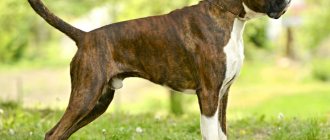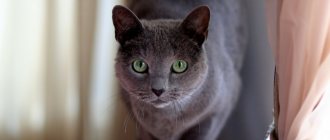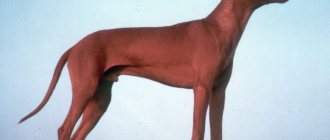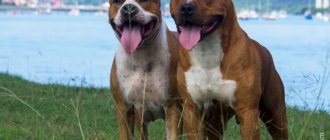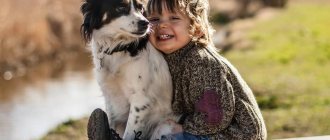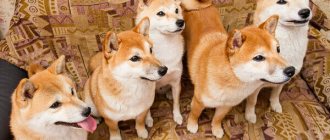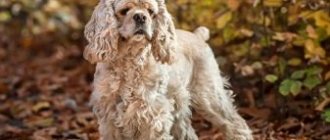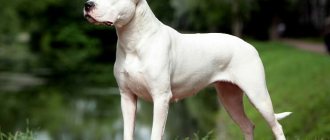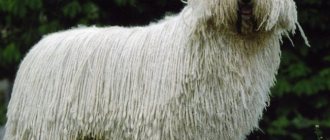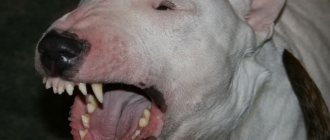Japan has always been a closed, exotic and attractive to Europeans. The isolation of the country also affected representatives of man’s four-legged friends. Only a few breeds from the Land of the Rising Sun are widely recognized in the world. The most popular breeds are Akita Inu, Japanese Spitz, and Japanese Chin. Others are practically unknown to a wide range of dog handlers. Currently, the situation is changing and original Japanese quadrupeds are of increasing interest to breeders.
The distinctive features of dogs from Japan are boundless devotion to their owner and excellent, flexible character. The words "ken" and "inu" are often found in breed names from Japan and are translated as "dog".
Akita Inu
The Japanese Laika belongs to the Spitz group and is the largest of them. Previously, they were called “matagi,” which literally means “bugbear.” This is due to the fact that the animal was originally used to lure large animals during hunting. The breed was bred in an area called Akita, which is known for harsh climatic conditions.
The breed has a distinctive appearance: a large head and triangular-shaped eye sockets. The body of these animals is well developed. Akitas cannot bark for long periods of time, but they are capable of making various snorting sounds.
Akita is well adapted to being kept in a variety of conditions. The abundant coat of wool prevents the breed from freezing even in severe winter. The breed does not require much effort in care; it is enough to comb the coat several times a week and bathe it when necessary. These dogs have an easy-going disposition. They are patient and loyal to children. Their calm temperament makes them ideal animals for people exposed to frequent stress.
Description of the breed and history of selection
The Japanese were involved in the breeding and selection of these large Spitz-type dogs. Their name comes from the Akita province (Honshu Island). Over time, they became a national treasure of Japan. Representatives of the guard selection were highly valued at the imperial court. Later they were taken to other countries to develop varieties of the breed.
Initially, it was an ancient hunting breed - relatives of huskies and huskies. They went with them to hunt wild boar and other game, calling them “matagi ken” (“large game hunter dog”). To enhance certain properties, the “bug dog” was crossed with mastiffs, Tosa Inu and shepherd dogs, almost completely losing the features of the Spitz.
Old photo of Akita Inu in Japan
The current name "Akita" is the place of origin, "inu" meaning "dog". It is known that in Japan, back in the 15th century, there were “breeding books” on the keeping and breeding of dogs of various breeds, including “matagi ken” (the predecessors of the Akita). There they wrote down everything about the breed - the nickname, distinctive features and characteristic habits of hunting dogs.
When they began to hunt less, the Japanese nobility began to look for guard, service and companion dogs. Representatives of this selection turned out to be almost universal. However, the elite breed was almost lost when, in times of famine, following the example of the Chinese, the islanders ate them, and made fur coats, hats and collars from their fluffy fur.
During World War II, representatives of the oldest Japanese breed were imported by military personnel. This is how the American variety was formed, but the Japanese refuse to recognize it. The first Akita came to the United States in 1937; she was brought by a disabled woman who learned the story about the dog Hachiko. The photo shows a Japanese and American Akita Inu (for comparison).
In memory of his unusual devotion, a statue of a dog named Kamikaze-go was erected at the Shibuya train station. Today everyone is familiar with the story about Hachiko as interpreted by Hollywood screenwriters with Richard Gere. Adults and children on the streets recognize the cute red Akita Inu dogs.
American Akita
This breed is not recognized by all canine organizations in Japan as a native breed. But the roots of the American Akita go far back in history. These dogs were used not only as hunting dogs, but also as herding dogs. These animals are distinguished by strong devotion to their owners. They have a pronounced dominant temperament. Proper training develops in them qualities that allow them to be patient with children. The American Akita can weigh up to 50 kg.
Akitas practically do not get along with other animals, as they see them as potential prey. Representatives of this breed love to chase other animals. Such dogs require a proper and well-thought-out training system. They do not like monotonous and monotonous activities. Otherwise, the American Akita begins to experience a lack of activity.
It is worth considering that these dogs have a heavy skeleton. Therefore, you cannot load the dog until the formation of the musculoskeletal system is completed.
How much does alabai cost?
There are a number of objective and subjective factors that determine the cost of an Alabai puppy. These include:
- exterior. Experts distinguish between excellent, good, simple and very simple. The price gradation is directly proportional to the assessment;
- signs (or lack thereof) of tribal marriage. This should be of greater concern to those who plan to participate in exhibitions or want to become a breeder. A dog with a plembrace is not suitable for this application. And don’t even doubt that he can become just a good friend and a reliable guard for you;
- puppy coat color. White alabai will cost much more.
The cost may also be affected by where the breeder lives. Statistics show that in Moscow and the region prices are higher than in the periphery.
Contrary to popular belief, the size of the puppy does not particularly affect the price. Nature alone knows what exactly your pet will be like as an adult.
The average prices for small Alabais start from 15 thousand rubles - most often these dogs have a breed, puppies of a simple exterior will cost in the range of 15-20 thousand rubles, for an Asian “with a future” you will have to pay at least 30 thousand rubles.
Remember that the puppy must have correct registration documents. Without them, it’s just a dog that looks like an Alabai. If you just love animals and want to make a loyal friend, then this warning is not for you. In the end, the degree of love, affection and loyalty has never been measured by the presence of this or that, even the most important, paper.
Jomon-shiba
The breed is very popular in Japan, but it has not become as widespread in other countries. The ancestors of the Jomon Shibs are ancient dogs that lived in mountainous areas. They have been domesticated and live as pets for humans for about a thousand years.
The Jomon Shiba is not approved by canine societies in Japan, but there are a large number of lovers of these dogs. In fact, this is a slightly modified wild dog, which in appearance, habits and disposition strongly resembles the Japanese wolf.
This breed retains all the features characteristic of primitive animals. They have a strong hunting skill, they are distinguished by courage and independence. For this reason, training must begin at an early age.
History of the Alabai breed
Experts believe that the age of the Alabai breed is from 3 to 6 thousand years. This is one of the most ancient dogs that have retained their original appearance to this day. Confirmation can be provided by a terracotta figurine found during excavations of a Bronze Age settlement and dating back to approximately 2000 BC. e. Interestingly, the dog’s tail and ears are cropped.
Alabai puppy
The differences in the names - Turkmen Alabai, Kazakh wolfhound - are due to the fact that the breed was originally formed over a fairly vast territory - from the Caspian Sea and the Southern Urals in the west and north to the foothills of the Dzungarian Alatau and Pamirs in the east and south, where several states are located today. From a geographical point of view, the most accurate name would be “Central Asian Shepherd Dog”, under which the breed is registered.
Descendants of ancient Molossians and Great Danes, Alabais were originally bred for herding and guard work. Nomadic tribes needed a dog that would have enormous strength, fearlessness, endurance and unpretentiousness. All these features were embodied in a gigantic animal with graceful, almost cat-like movements and a proud look.
The spread of Alabais outside Central Asia began approximately in the 30s of the last century, and professional breeding of the breed in kennel clubs started even later. Maybe this is for the better - man simply did not have enough time to spoil what was inherent in this amazing dog through thousands of years of natural selection.
In the summer of 1990, the State Agricultural Industry of the Turkmen SSR approved the breed standard “Turkmen Alabai”. On the territory of the Russian Federation, FCI standard No. 335, published in January 1989, is applied. According to this classification, the breed is called “Central Asian Shepherd Dog”. Since then, no changes have been made to the standard. The purebred Turkmen wolfhound is recognized as a national treasure of Turkmenistan (along with Akhal-Teke horses) and is prohibited from being exported from the country.
Alabai
Kai
This breed is called differently. Kai is an aboriginal dog that has long been recognized as a mongrel. The breed originated in the mountainous regions of Japan. The isolation of these territories made it possible to preserve the purebred of these dogs. Currently, this is a breed of classic Japanese dogs used in hunting. They reach a weight of up to 20 kg, have a powerful skeleton and developed muscles, and short fur. Their coat color is most often brindle: dark stripes on a brown or beige background.
Read: Medium-sized dogs are ideal pets for an apartment
The dog has independence and independence. Kais remain devoted to one person for life. They have some tendency to dominate, but rarely show aggression. They need proper training. Kais are pack dogs, so they require socialization from the first months of life. Although these dogs are not aggressive and are quite adequate in the company of strangers, they are advised to be kept outside the city.
These dogs need increased physical activity.
Kishu
This rare breed was formed in ancient times on the territory of the Kishu Principality. It is distinguished by straight hair, erect ears and a curved tail.
The breed has good health and immunity. Kishu are well suited for hunting, but can also be used as guard dogs.
Kishu have a calm disposition. Like other dog breeds bred in this country, it is distinguished by its independent character and independence. They are difficult to train.
They are distinguished by their courage and affection for their owner. They are active animals that require long daily walks. Living in a big house suits them best.
Ryukyu
The Ryukyu originated on the island of Okinawa. The animals have an extremely ferocious appearance, which makes them look like wild dogs. They have a friendly disposition. They quickly become attached to humans. The instinct to protect the territory is strongly expressed, because of this they do not get along well with other animals. Previously, Ryukyu were used as assistants in hunting large animals. The color can be various shades of red and brown. There are up to ten color variations.
Not so long ago, this breed was in danger of extinction, but through the crossing of some genetic species, their numbers were able to increase.
Historical reference
On the lands of present-day Japan, remains were found that belonged to the ancestors of this breed in the 2nd millennium BC. There, on artifacts, her images were found. The first dogs, similar in appearance to modern huskies, arose in one of the northern provinces on the island of Honshu in the 17th century. They haven't changed since then.
Royal favorites
These were the favorites of high-ranking officials and the emperor himself. Their content was transformed into a whole ceremony. Everyone had a servant. Special accessories were made for them.
The status of the pet and its owner was determined by the type of collar . They became elite since the 18th century. Until this moment, they were started by peasants and hunters. It was a symbol of prosperity and family well-being.
Purity of blood
The breed belongs to a minority, among which there are no foreign impurities. It was not mixed with foreign genes. In order to preserve it, the Society for the Protection of Crossbreeding with Other Species was formed. severe punishment was imposed for offending or killing this dog .
Brave Helpers
During World War II, many individuals were sent to the front lines to help soldiers. Then breeding slowed down due to a shortage of food and funds for their care. Only a few purebred males and females were saved, which made it possible to restore their population in the post-war period.
Sakhalin Husky
In Japan this breed is called Karafuto-Ken. These dogs are considered endangered. A small number of them are preserved only in the land of the rising sun. Once upon a time, animals were bred in Russia for cargo transportation, so the dog is distinguished by its strength, rather large size and independence from the first months of life. They have beautiful and thick fur. Today they are used for decorative purposes, but have not lost their qualities.
The breed has a calm disposition, good health and endurance. Huskies are active animals that need proper training. This requires an experienced dog breeder.
Read TOP hairless and hairless dogs - 9 breeds with names
Dogs are distinguished by their attachment to their owner. If necessary, they can become aggressive.
Huskies first appeared in Russia, where they were called Sakhalin huskies, but today these rare dogs are under Japanese control.
Appearance of the Central Asian Shepherd
Impressive size, strong constitution and thick coat are the key characteristics of the Alabai’s exterior.
Height
The height at the withers of a male is at least 70 cm, of a female - 65 cm. More significant growth is encouraged while maintaining a harmonious build.
Weight
An adult Alabai male weighs from 50 kg, a female – from 40 kg.
Head
Alabai muzzle
Massive in proportion to the overall texture of the body, the shape of the head (side and top views) is close to rectangular. The skull is flat, long, with a well-developed occipital protuberance. Stop – moderate.
Muzzle
Blunt, medium length, almost not tapering towards the nose. The back is usually straight, although a slight hump is allowed. The chin is well defined. The nose is large, but does not protrude beyond the general contour of the head. The color of the lobe is black; in white and fawn Alabais it can be lightened. Lips preferably have black pigmentation; the upper lip covers the lower jaw with closed teeth. The jaws are wide and strong, the teeth are white, even, and the bite is scissor-shaped.
Eyes
Alabai's eyes are oval-shaped and medium in size. Widely spaced. Color – from light to dark brown. The eyelids, regardless of color, are always black.
Ears
Low set, triangular in shape, hanging. Ears are cropped in the countries of origin or where the law does not prohibit this.
Neck
The Alabai neck is of medium length and muscular. As a special feature of the Central Asian Shepherd Dog, the dewlap stands out.
Back
Adult male Alabai
Straight, wide, with well-developed muscles. The loin is short, slightly convex, powerful.
Breast
Deep, wide and quite long, widening towards the back. The lower part of the chest is lowered to the level of the elbows, and sometimes lower.
Tail
The tail of the Alabai is set high and quite thick at the base. Before docking, it is crescent-shaped. Sometimes in the last third of the length it can be rolled into a ring. Both options are equally acceptable - a docked or natural tail.
Front legs
Straight, parallel. The backbone is strong.
hind legs
Straight, parallel with strong bones. Set slightly wider than the front ones.
Paws
Large, round, collected in a lump. Claw color - any.
Wool
The Alabai has coarse, straight and thick fur. The undercoat is well developed. There are short-haired Alabais (hair length 3-5 cm) and dogs with longer hair (5-7 cm). Asians of the second type are characterized by a small mane on the neck, feathering behind the ears, on the limbs and tail.
Color
Any except blue, brown and black.
Faults, defects and disqualifying characteristics are determined by experts depending on the severity and severity of certain deviations from the CAO breed standard.
Shiba Inu
These animals are highly disciplined and have the ability to learn. They easily interact with other pets, but they perceive birds as prey. They need early socialization. Due to its pronounced independence, the right approach needs to be found for this breed. This breed is loyal to its owner, but strives to defend leadership.
It takes a lot of time, effort and attention to train and educate. The desired results can only be achieved without the use of force. Shiba Inus are easy to train. A dog can live not only in an enclosure, but also in an apartment, but it must be taken into account that the animal needs frequent physical activity.
Health and life expectancy
Hokkaido live about 12-14 years. This is a relatively healthy breed that is resistant to all congenital diseases and has virtually no genetic pathologies.
About 1/3 of dogs suffer from collie eye anomaly, while 2/3 are carriers of this defect. The anomaly is a form of hereditary eye disease that affects the sclera, retina and choroid. There is no cure for this disease, but fortunately it rarely leads to blindness.
Collie eye abnormalities are diagnosed using ophthalmoscopy in puppies at 6-7 weeks of age. Therefore, if you decide to buy this dog, be sure to check with the breeder whether the puppies have been examined for this disease. In addition to AHA, this breed also suffers from hip and elbow dysplasia, hypodontia, cryptorchidism, and some forms of allergies.
Shikoku
Shikoku was recognized as a monument of Japan in 1982 by the International Canine Organization. This is one of the oldest breeds in Japan. This type of dog has an independent and friendly temperament, easily gets along with people, but does not tolerate strong sentimentality.
Shikoku are good hunters and excellent guides. Living in an apartment does not suit them. They require long walks outside. This need is caused by a developed hunting instinct. Shikoku dogs are suitable for indoor living.
They are red or brindle in color. To properly raise a puppy, it is important to have certain skills, since during training animals show character. The animal needs to be brushed once a week and bathed as needed.
Medium breeds
Shiba Inu.
A Japanese dog bred for hunting. A distinctive feature of the Shiba Inu is their silence; they practically do not bark. The dogs are very active and energetic . They are distinguished by their sharp mind, excellent hunting instincts and friendliness towards others. Shiba has a muscular, well-built body. The height at the withers can reach 40 centimeters with a weight of 10 kilograms. The dog requires increased attention to its coat. It is necessary to comb the animal regularly. Long active walks with games should become the norm for the owner of a Shiba.
Hokkaido.
The national breed of Japan , the export of which is strictly prohibited, so it can only be found in its homeland. Currently, the breed is on the verge of extinction due to its small number of representatives. Dogs reach 50 centimeters at the withers and weigh up to 26 kilograms. A descendant of sled dogs, he has the capricious, freedom-loving character of a true Japanese. With proper training, it can become an excellent pet for the whole family. Capable of becoming an excellent watchman and security guard for household members. The dog constantly requires long walks and serious physical activity to maintain fitness.
Shikoku.
Similar in appearance to the Shiba Inu dog, it is, however, less common in Japan. The main feature of this breed of Japanese dogs is its color. As a born hunter, Shikoku is distinguished by endurance, increased activity, and also a sharp mind. Shikoku's height is about 50 cm, and his weight reaches 25 kilograms. When training, it should be taken into account that the dog has very developed hunting instincts and it will take a lot of time to correct them.
Sanshu.
Officially unrecognized young breed , bred by crossing aboriginal dogs with Chow Chow. At the moment, the breed is developing and is positioned primarily as a companion dog. The height of the dogs reaches 45 centimeters at the withers with a maximum weight of 26 kilograms. Color varies from white to fawn. Sanshu are easy to train and are loyal and friendly. They have a balanced, gentle character.
Tosa Inu
In Japan, mastiffs were bred as fighting animals. Local dogs were crossed with European dogs to enhance certain characteristics. These animals are not suitable for novice dog breeders due to their stubbornness and developed strong-willed qualities. The breed has increased aggressiveness. Good training will make a mastiff an excellent companion and watchman.
Mastiffs reach a weight of 100 kg. They have a massive head, floppy ears and well-developed muscles. It is important to start raising puppies of this breed in the first months. Dogs of this breed have a hard time living in an apartment. They are contraindicated for families with children and other pets. The severe mastiff tolerates only its owner on its territory.
Representatives of the breed require long walks and exercise. With their deficiency, the dog begins to show unmotivated aggression.
Kai Inu (Brind Dog)
Bred in the province of Kai (Honshu Island). Belongs to hunting breeds. Kai Inu is a national treasure of Japan. The number of purebred Kai Inu, including during the difficult period of the Second World War, was preserved thanks to the tax benefits introduced by the prefecture for their owners.
Kai Inu has a calm and loyal character. The dog is well built, has an athletic appearance and a developed hunting instinct. Swims well and can climb trees growing at an angle. Its gregarious nature allows it to easily get along with other relatives. She is a silent dog and only speaks up when absolutely necessary.
The breed standard stipulates a height of 47–53 cm for males, 42–48 cm for females, weight for males — 16–25 kilograms, females — 11–20 kilograms.
Life expectancy is 12–15 years.
The Kai Inu is called a brindle dog because of its characteristic stripes of different colors - brindle and red, brindle and black, brindle. Newborn Kai Inu have a uniform color and as they grow older they acquire the stripes characteristic of this breed.
The Kai Inu's coat is prone to matting and requires weekly brushing.
Difficulties may arise during training due to the proud, wayward nature of the dog. Training must be carried out by one person. The recommended age for starting classes is 3–4 months. Given its hunting instincts, the animal will require early socialization.
Kai Inu is a dog of one owner, so it will obey him unquestioningly, but only under the condition of unlimited authority. She will treat all household members equally, but it is important for her to identify a leader.
The animal gets along well with teenage children. It is not recommended to leave young children alone with a Kai Inu: careless handling of a dog as a toy by a child can cause a negative reaction from the pet.
Although keeping an animal is possible in an apartment, it is preferable to have a private house with a fenced area for the pet. Kai Inu cannot be left without a leash outside a closed area.
The breed is suitable for active people with a strong, purposeful character. Kai Inu is an excellent assistant for hunting and active walks with the owner. In the absence of physical activity, character may deteriorate and behavior may change for the worse.
Hokkaido
This breed of dog is considered Spitz-type. It originated on the island of Hokkaido and was originally used for hunting bears. The breed is quite small. Because of this, the price of these animals is quite high. Even in Japan their numbers are small.
Dogs of this breed have a developed wide skull and a flattened muzzle, they have pronounced muscles and strong hind limbs. The breed formed almost independently without the participation of breeders. All the characteristic features of the Hokkaido breed were formed as a result of the influence of climatic conditions. They retain the features of primitive dogs.
Their character is characterized by unpredictability - they combine harshness with an affectionate disposition, and temporary aggression with gentleness. In order to balance their temperament, proper training without the use of force is necessary.
Japanese Terrier
This dog breed is considered rare even in Japan. Their number does not exceed 2000 individuals. When breeding the breed, Dutch and English fox terriers and Italian greyhounds were used, which were crossed with local dogs.
Read Black dogs - 20 breeds with names and photos
They began to be bred at the beginning of the last century. The parameters of this breed were approved only in the 30s. The Japanese Terrier is recognized as an official breed throughout the world. But these dogs did not gain much popularity.
These lapdogs are usually used as companions, but they can also be used as hunting dogs. Japanese Terriers are adapted to work on land and in water. They are distinguished by their good nature and sensitivity. The breed gets along well with children. With proper training, it can be used as a watchman or hunter.
Japanese terriers cannot tolerate low temperatures, so they need to be insulated for walks. At home they should be protected from drafts. This breed is also sensitive to food. Sweets and smoked foods are prohibited, otherwise they will develop various whitening problems. They need high quality food.
Japanese dogs
You can often guess the origin of Japanese dogs just by the name of the breed: the short prefix “inu”, which is translated from Japanese as “dog,” indicates that they belong to Japan. However, not all local dogs have it, and almost every breed has several names, from very ancient to quite modern.
Native Japanese breeds
Nippo, the name of the main organization of Japanese dog handlers, has its own small registry of six national breeds officially recognized by this association. These dogs are similar in appearance, like twin brothers, and differ only in color and size.
It should be noted that there are several more intrabreed types that have reason to claim the status of an independent breed - they even have their own names. But Nippo does not recognize them and continues to consider them only varieties of the original breeds.
Akita Inu
Akita Inu (Japanese Akita) has a deceptive appearance. A cute dog that looks like either a fox cub or a teddy bear is included in the lists of the most dangerous breeds in several countries.
Akita Inu can have three colors: red and white, pure white brindle and white.
This is the largest of the native Japanese breeds and was used as an effective wild boar hunter. Willful, dominant, does not tolerate physical pressure and familiarity, but behavioral problems are corrected by training, which the breed lends itself well to. A skillful and selfless protector for his masters and their property. Suitable for families leading an active lifestyle; Not recommended for older people and teenagers.
Average height at the withers is 70 cm, average weight is 50 kg. The starting price of a puppy is 30 thousand rubles.
Shiba Inu
The Shiba Inu is an ancient breed with at least four within-breed types. The breed is considered a national treasure, and it was bred on the island of Honshu.
The Shiba Inu has four recognized colors: black and tan, red, snow white and the so-called sesame.
An excellent working dog used in hunting game birds: mainly ducks and pheasants. She is self-sufficient and difficult to get used to people, so owners are advised to start socializing the puppy as early as possible. They are restive and cunning, but at the same time very smart, inquisitive and playful. They get along well with children in the family, but are wary of strangers of any age. The breed is recommended for experienced and patient owners.
Average height at the withers is 38 cm, average weight is 12 kg. The starting price of a puppy is 50 thousand rubles.
Kai Inu
Kai-inu (kai, ryuku, tora) is a very rare breed; there is no data on the presence of such dogs in Russia. The Torah was developed in northern Japan, in the Yambaru province; The main purpose is boar hunting.
Kai Inu can be red brindle or black brindle.
A very calm and strong-willed dog, when hunting it fully displays passion, aggression and courage. A monogamous dog is strongly attached to only one owner and treats members of his family evenly and patiently. Education and socialization must begin at an early age. Does not tolerate apartment living well, prefers yard living; needs active loads.
Average height at the withers is 52 cm, average weight is 30 kg. The starting price of a puppy is 100 thousand rubles.
Kochi Inu
Kochi Inu (Shikoku, Kochi-ken) is a very rare hunting and guard breed native to the island of Shikoku. It is recognized as a natural monument of Japan, but is almost never found even in its own country.
Shikoku - allowed colors for the breed: sesame, black, red, brown
Whatever color this dog is, it strongly resembles a wolf in both appearance and habits. Shikoku is very strong and active, moving quickly and easily over rough terrain. Willful and freedom-loving, she cannot stand being kept on a leash. It is prone to escape and is very jumpy, so the area where the Kochi Inu lives should be fenced with a high fence. It is easy to train, but will follow commands only if it recognizes the authority of the owner or trainer.
Average height at the withers is 52 cm, average weight is 25 kg. The starting price of a puppy is 80 thousand rubles.
Kishu Inu
Kishu Inu (kishu, kishu, kishu-ken) is a primitive hunting breed that was formed on the Kii Peninsula, where the ancient principality of Kishu was located. National treasure of Japan. Three intra-breed types are differentiated primarily in connection with the main objects of hunting.
Kishu Inu - breed colors: white, red, zone
The Japanese are convinced that kishu contains a significant proportion of wolf blood, and perhaps this opinion is not unreliable. In everyday life this is a balanced and calm dog; on a hunt or in a critical situation, she transforms beyond recognition, showing determination, indomitable energy and courage. It can be a watchman or even a shepherd, but it makes no sense to train kisyu for protective guard duty.
Average height at the withers is 52 cm, average weight is 26 kg. The starting price of a puppy is 120 thousand rubles.
Hokkaido
Hokkaido (seta, ainu-ken) - the breed was bred by the aborigines of the island of Hokkaido for hunting bears. There are several territorial breeding lines - breeders have different ideas about the desired breed type.
Hokkaido - the breed is characterized by a large palette of colors: sesame, brindle, red, black, black and tan, white
An extremely active and inquisitive animal that will require a lot of time and attention from the owner. If this dog is limited in physical activity, it will begin to dismantle the house into molecules. But you can’t deny the intelligence and intelligence of the Hokkaido - they train well and with pleasure. A pronounced hunting instinct makes it difficult to keep a dog together with any other pets; it is not advisable to leave them alone with small children.
Average height at the withers is 49 cm, average weight is 25 kg. The starting price of a puppy is 80 thousand rubles.
Recognized Japanese breeds
This subgroup includes breeds officially recognized by the FCI, which are not considered native Japanese, although they were selected in the country.
Hin
The Japanese Chin is a real samurai, only very small. Among the original breeds from which the chin traces its ancestry are Pekingese and spaniels.
The Chin is an ideal companion that easily adapts to any owner's lifestyle.
Chins delighted the gaze of the Japanese emperors and were “restricted from traveling abroad” for a long time, then they came to England, from where they spread throughout the world. Small, very elegant decorative dogs with long hair of white-red or white-black color. The dog has a proud, but docile and easygoing disposition, and very rarely barks. He trains well, but not for “yummy food”, but for praise. Considered an ideal apartment pet.
Average height at the withers is 23 cm, average weight is 2.5 kg. The starting price of a puppy is 25 thousand rubles.
Japanese Spitz
The Japanese Spitz is an ornamental breed developed approximately a hundred years ago using various Spitz breeds.
The Japanese Spitz is famous for its thick, snow-white coat with a thick undercoat.
They are unpretentious and easy to maintain, despite their pampered appearance and “stainable” wool. They are hypoallergenic, do not have the characteristic dog odor and are extremely silent. Little brave people, touchingly attached to people, Japanese Spitz do not like loneliness and need attention and affection. Very playful and positive.
Average height at the withers is 35 cm, average weight is 8 kg. The starting price of a puppy is 30 thousand rubles.
Tosa Inu
The Tosa Inu (Japanese Mastiff) is a serious and large guard breed, considered potentially dangerous in several countries. Bred for dog fighting by crossing indigenous breeds with European ones: mastiffs, St. Bernards, Great Danes and bulldogs.
Tosa Inus do not tolerate other pets and have difficulty accepting human leadership
An experienced, powerful and uncompromising fighter - the only Japanese breed of such “specialization”. Barks rarely and only for business. The content is simple, training requires experience and a strong-willed approach. The owner will have to try very hard to prove to the dog his right to leadership.
Average height at the withers is 60 cm, average weight is 80 kg. The starting price of a puppy is 60 thousand rubles.
Japanese Terrier
Japanese Shorthair Terrier (Mikado Terrier, Japanese Fox Terrier, Kobe Terrier) - there are no more than two thousand dogs of this breed all over the world, and one and a half of them are in Japan. When bred, smooth fox terriers, Italian greyhounds and Manchester terriers were used, which were bred to the now extinct miniature aboriginal dogs.
The Japanese Terrier has excellent hearing, so it is considered a good guard dog, despite its size.
A very sensitive, cautious, but fast and energetic dog. It is difficult to get used to new people, does not tolerate rudeness and shouting. She is great friends with children, but should not be kept with domestic animals.
Average height at the withers is 30 cm, average weight is 3 kg. The starting price of a puppy is 100 thousand rubles.
Japanese Chin
These decorative animals were bred in Japan and have become very popular around the world. To breed them, Tibetan spaniels and Pekingese were used. Japanese Chins are the favorite dogs of the imperial family and continue to live in the palace today.
The animals have small ears and a tail with thick hair. With proper combing, there will be no problems with shedding.
In Japan, these dogs symbolize Buddha. In ancient times, only members of the nobility owned chin. Today these dogs are used as companions. Representatives of the breed are quite intelligent and have a good disposition. They get along well with children and make contact easily. They are able to exist in small spaces, so they are suitable for keeping in a small apartment. They are easy to train, the main thing is not to let the chin get bored.
Hin
Japanese Chins were developed back in the 14th century. They weigh no more than 3.5 kg and are no more than 26 cm tall. Animals are considered the best companions for humans. An interesting fact is that they have some habits that are typical of cats.
The chin can live in any room, including a small closet. These dogs cannot survive on the street, so enclosure conditions are completely unsuitable for them, much less living on a chain.
Dogs have small ears, a very beautiful tail, and thick hair. Sometimes it may seem like this dog is shedding a lot. This is not true - if you brush your pet regularly, then it will not cause any problems with shedding.
Hin is easy to train; he will carry out all tasks easily and naturally. But when the training is monotonous and boring, the pet will not perform a single task. You should also prepare for the fact that all classes can be very difficult, because the animal requires attention to itself.
The dog behaves somewhat shyly around strangers. And if they are silent all the time, then the animal will copy exactly the same character traits.
Japanese Spitz
This breed differs from other Spitz representatives by its special external elegance. The dogs were bred in the 20s of the twentieth century. Representatives of this breed have an easy-going and friendly disposition. These qualities make them excellent companions and are well suited for families with children. They are often used as circus animals due to their beautiful appearance.
These dogs have an elongated muzzle with a round forehead, triangular ears and large eyes. The bushy tail almost curls over the back. Their coat color can only be white. They have well-developed guard instincts: when approaching a stranger's house, they begin to bark loudly.
Animals of this breed can live up to 17 years. But for this it is important to monitor the balance of their diet and provide proper care. It is also important to observe the frequency of brushing the coat. And also clean your ears and teeth.
Japanese Spitz quickly get used to life, both in an apartment and outside the city. But they have a hard time withstanding sudden changes in weather.
How to choose a puppy
It is better to purchase an Alabai puppy from a nursery or from breeders of this breed. This will give you certain guarantees of the purity of the breed and the health of the dog, both physical and mental. When choosing a baby, experts recommend paying attention to the following points.
- Puppy age. It is better to take a Central Asian Shepherd dog at least two months old. By this time, the animal has already completed the necessary vaccination course and the activation procedure, which is provided for by law.
- Mother's age. The healthiest offspring are obtained from bitches between the ages of two and eight years. The previous birth must have taken place at least a year ago.
- Number of babies in the litter. Experts say that the optimal number of puppies is six.
- Floor. Girls are more inquisitive and active, but are not as confident in their abilities as males. But if you have small children in the house, then it is better to give preference to the young lady.
- Puppy behavior. Alabai is a strong animal by nature, a leader dog. These qualities should also be seen in children. Drop a book on the floor or tap your hand on the enclosure net - the puppy who is immediately interested in new sounds is definitely suitable to be your friend.
Don’t forget to evaluate the appearance of the shepherd. A healthy baby is active, eats with appetite, has a shiny coat and clear skin. The nose is moist, the ears and eyes are clean. There are no signs of indigestion under the tail. The Alabaika should be of medium (compared to other puppies in the litter) size; small and overly large puppies should be culled immediately.
Pay attention to the wool too. The little dog's one is plush and short. Long hair indicates that one of his ancestors “sinned” with the Caucasian Shepherd Dog.
But the most important thing is that before buying a puppy you must be sure that it is the Alabai that you need.
